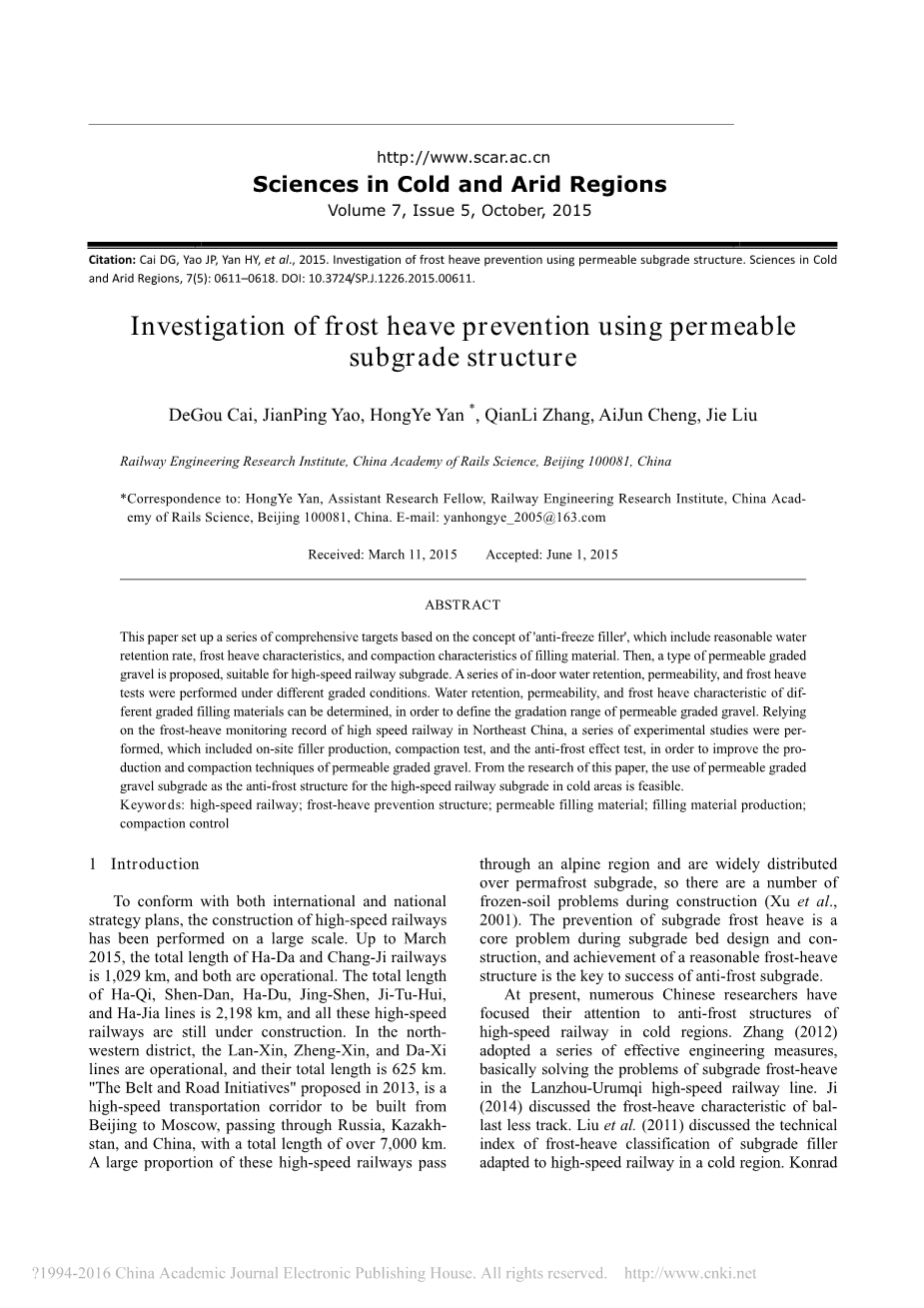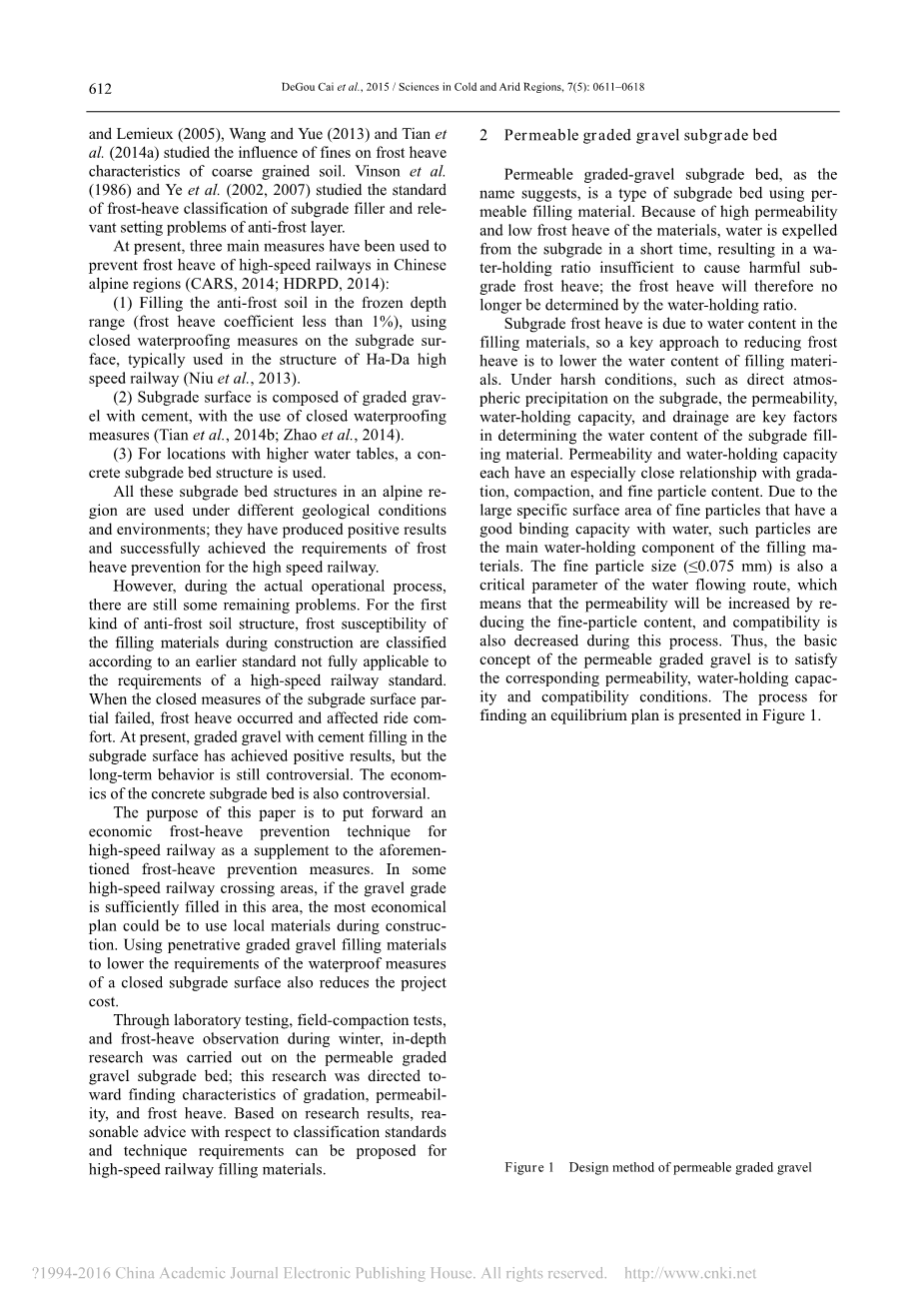

英语原文共 8 页,剩余内容已隐藏,支付完成后下载完整资料
Investigation of frost heave prevention using permeable
subgrade structure
DeGou Cai, JianPing Yao, HongYe Yan *, QianLi Zhang, AiJun Cheng, Jie Liu
Railway Engineering Research Institute, China Academy of Rails Science, Beijing 100081, China
*Correspondence to: HongYe Yan, Assistant Research Fellow, Railway Engineering Research Institute, China Academy of Rails Science,Beijing100081,China.E-mail:yanhongye_2005@163.com
Received: March 11, 2015 Accepted: June 1, 2015
ABSTRACT
This paper set up a series of comprehensive targets based on the concept of #39;anti-freeze filler#39;, which include reasonable water retention rate, frost heave characteristics, and compaction characteristics of filling material. Then, a type of permeable graded gravel is proposed, suitable for high-speed railway subgrade. A series of in-door waterretention, permeability, and frost heave tests were performed under different graded conditions. Water retention, permeability, and frost heave characteristic of different graded filling materials can be determined, in order to define the gradation range of permeable graded gravel. Relying on the frost-heave monitoring record of high speed railway in Northeast China, a series of experimental studies were performed, which included on-site filler production, compaction test, and the anti-frost effect test, in order to improve the production and compaction techniques of permeable graded gravel. From the research of this paper, the use of permeable graded gravel subgrade as the anti-frost structure for the high-speed railway subgrade in cold areas is feasible.
Keywords: high-speed railway; frost-heave prevention structure; permeable filling material; filling material production;compaction control
1 Introduction
To conform with both international and national strategy plans, the construction of high-speed railways has been performed on a large scale. Up to March 2015, the total length of Ha-Da and Chang-Ji railways is 1,029 km, and both are operational. The total length of Ha-Qi, Shen-Dan, Ha-Du, Jing-Shen, Ji-Tu-Hui, and Ha-Jia lines is 2,198 km, and all these high-speed railways are still under construction. In the northwestern district, the Lan-Xin, Zheng-Xin, and Da-Xi lines are operational, and their total length is 625 km. 'The Belt and Road Initiatives' proposed in 2013, is a high-speed transportation corridor to be built from Beijing to Moscow, passing through Russia, Kazakhstan,and China, with a total length of over 7,000 km. A large proportion of these high-speed railways pass through an alpine region and are widely distributed over permafrost subgrade, so there are a number of frozen-soil problems during construction (Xu et al.,2001). The prevention of subgrade frost heave is a core problem during subgrade bed design and construction,and achievement of a reasonable frost-heave structure is the key to success of anti-frost subgrade.
At present, numerous Chinese researchers have focused their attention to anti-frost structures of high-speed railway in cold regions. Zhang (2012)adopted a series of effective engineering measures, basically solving the problems of subgrade frost-heave in the Lanzhou-Urumqi high-speed railway line. Ji (2014) discussed the frost-heave characteristic of ballast less track. Liu et al. (2011) discussed the technical index of frost-heave classification of subgrade filler adapted to high-speed railway in a cold region. Konrad and Lemieux (2005), Wang and Yue (2013) and Tian etal. (2014a) studied the influence of fines on frost heave characteristics of coarse grained soil. Vinson et al.(1986) and Ye et al. (2002, 2007) studied the standard of frost-heave classification of subgrade filler and relevant setting problems of anti-frost layer.
At present, three main measures have been used to prevent frost heave of high-speed railways in Chinese alpine regions (CARS, 2014; HDRPD, 2014):
(1) Filling the anti-frost soil in the frozen depth range (frost heave coefficient less than 1%),using closed waterproofing measures on the subgrade surface, typically used in the structure of Ha-Da high speed railway (Niu et al., 2013).
(2) Subgrade surface is composed of graded gravel with cement, with the use of closed waterproofing measures (Tian et al., 2014b; Zhao et al., 2014).
(3) For locations with higher water tables, a concrete subgrade bed structure is used.
All these subgrade bed structures in an alpine regionare used under different geological conditions and environments; they have produced positive results and successfully achieved the requirements of frost heave prevention for the high speed railway.However, during the actual operational process,there are still some remaining problems. For the first kind of anti-frost soil structure, frost susceptibility of the filling materials during construction are classified according to an earlier standard not fully applicable to the requirements of a high-speed railway standard.When the closed measures of the subgrade surface partial failed, frost heave occurred and affected ride comfort.At present, graded gravel with cement filling in the subgrade surface has achieved positive results, but the long-term behavior is still controversial. The economics of the concrete subgrade bed is also controversial.
The purpose of this paper is to put forward an economic frost-heave prevention technique for high-speed railway as a supplement to the aforementioned frost-heave prevention measures. In some high-speed railway crossing areas, if the gravel grade is sufficiently filled in this area, the most economical plan could be to use local materials during construction.Using penetrative graded gravel filling materials to lower the requirements of the waterproof measur
全文共29972字,剩余内容已隐藏,支付完成后下载完整资料
资料编号:[13123],资料为PDF文档或Word文档,PDF文档可免费转换为Word
以上是毕业论文外文翻译,课题毕业论文、任务书、文献综述、开题报告、程序设计、图纸设计等资料可联系客服协助查找。


